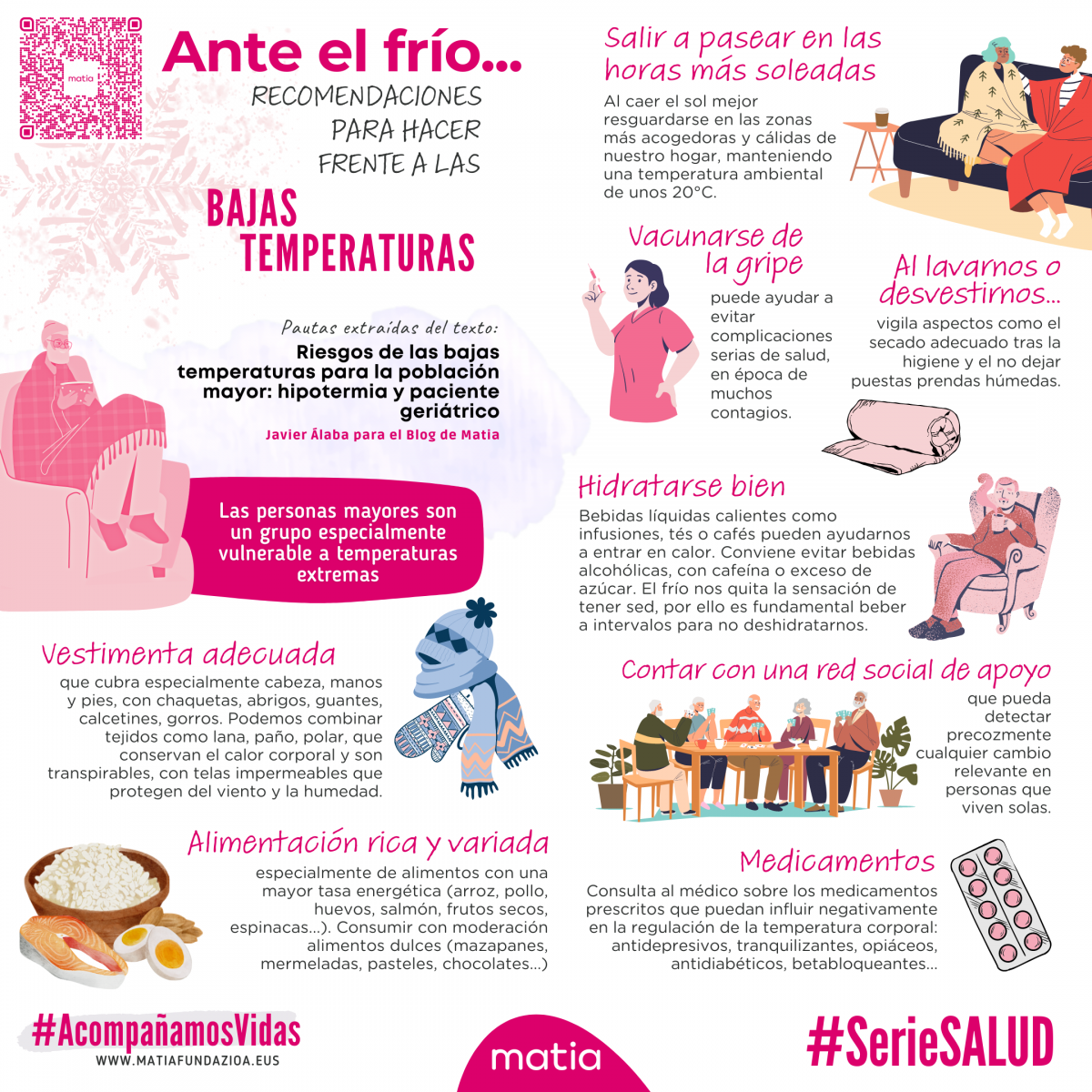
Risks of low temperatures for the elderly: hypothermia and the geriatric patient
The current global context, with very high energy prices and forecasts of record low temperatures for the winter, leads us to believe that many households will have to live with a particularly cold Christmas in terms of temperature.
What does this mean for older people, and are they particularly vulnerable to such severe weather conditions? And if so, can we reduce the risks of cold for the older population?
Let's see what the literature points to.
Body thermoregulation in old age
As we have been discovering, our body temperature is regulated by different mechanisms. Some, the so-called "voluntary" ones, are related to our clothing, to the food we have eaten...; others, to aspects related to the way our body functions (cellular metabolism, cardiac and hepatic output), and to heat loss (through muscular contractions, vascular or hormonal changes).
Over the years, these mechanisms gradually lose their ability to adapt, especially to extreme temperatures. As the ability to perceive cold decreases, changes in vascular diameter to save energy become less efficient.
The deficit of adrenergic hormones also influences a reduced involuntary motor response to cold. If we add to all this the influence of different metabolic pathologies, such as hypothyroidism, adrenal insufficiency or malnutrition, and the different drugs that can act on the pathways that regulate body temperature (antidepressants, tranquilisers, opiates, anti-diabetics, beta-blockers, etc.), it is understandable that these alterations are more frequent in this population group.
The presence of functional dependence in relation to dementia, the after-effects of cerebrovascular or osteoarticular disease, increases immobility and reduces the capacity to generate heat.
But in addition to psychobiological, nutritional or functional variables, we must not lose track of other socio-economic variables that also play an important role in this matter, such as the high rates of poverty and involuntary loneliness that accompany this vitality.
Risks, causes and manifestations of hypothermia in older people
The presence of hypothermia, understood as a body temperature below 35ºC, increases overall mortality by 40%. In people over 75 years of age, mortality is multiplied by five (a value that increases as the number of pathologies increases).
Thus, in diabetics, given the vascular alterations present, the risk of hypothermia is multiplied by six.
In infectious processes, hypothermia is as serious as sepsis.
Hospital admissions, whether medical or surgical in nature, are another frequent cause of hypothermia in the elderly, affecting 3.6% of this population in some series, and up to 10% in winter periods.
The most common and mildest manifestations of hypothermia are fatigue, muscle weakness, psychomotor slowing, bradycardia and hypotension. In more severe forms it can progress to lethargy, stupor or coma and trigger different types of arrhythmias.
At low temperatures, antiarrhythmic drugs may not act adequately due to changes in the cell membrane, and resistance to the effect of insulin may occur, so we must bear in mind that when the body temperature is lowered, there may be an increased effect of the different drugs prescribed.
Combating the risk of hypothermia in older people
Therapeutic measures can be passive, by means of blankets, coats, increases in ambient temperature, which require a minimum physiological reserve; or active, by means of infusion of serum or hot air.
At the community level, in situations of large temperature fluctuations, prevention is relevant, maintaining an ambient temperature in the home above 20ºC, appropriate clothing that especially covers hands and feet, with jackets, coats, gloves, socks and hats. It is also advisable to take care to dry properly after hygiene and not to leave damp clothes on.
As we pointed out at the beginning, a rich and varied diet, especially of foods with a higher energy content, as well as adequate hydration, including hot drinks such as herbal teas, teas or coffees, can help.
Check with a specialist whether it is necessary and advisable to take medication that may have a negative influence on body temperature regulation.
It is also important to have a social support network that can detect early on any relevant changes in people living alone or to have an operational telecare system, and in dependent people, that caregivers attend to these basic needs in a dynamic way.
And something fundamental. If it is very cold, it is better to stay at home, installed in the most cosy and quality areas of our home.



Add new comment